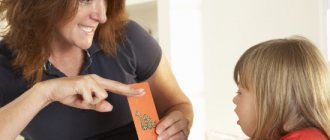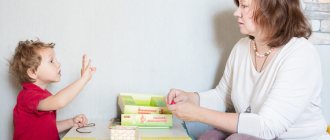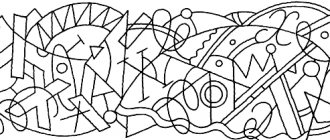Working on vowels
- Pronouncing a series of two, three or more sounds:
- accompanied by symbols (“Men - sounds”)
- without visual support.
- Pronunciation of a number of vowels with emphasis on one of them (also - with support for clarity and without it - by ear).
- Recognition and pronunciation of a series of vowels from the silent articulation of an adult.
- "Musical Ball"
An adult, throwing a ball to a child, makes one or two (at the next stage more) sounds. The child repeats and returns the ball.
- Pronouncing a series of vowels, changing the volume, tempo, “mood” (sad, angry, affectionate) of the voice.
- Pronounce as many vowels as there are flowers in the meadow.
- Stand up when a series of two (or other specified number) sounds sounds.
Developing a sense of tempo
Goal: to teach to distinguish, reproduce, characterize tempo based on tactile-kinesthetic, visual, and auditory sensations.
- "Mouse and Cat"
An adult shows the children how easily and quickly a mouse runs on its toes, and a cat slowly sneaks behind it. The movements are performed in a circle to the sound of a tambourine. For frequent blows - quickly, like a mouse, for rare blows - slowly, calmly, like a cat.
- "Fists - palms"
An adult reads a poem, and children perform hand movements at the right pace:
Anyone has two fists, one knocks lightly on the other: Knock - knock, knock - knock. Well, the palms don’t lag behind, they beat them cheerfully: Clap - clap, clap - clap. The fists beat faster, how hard they try: Knock - knock - knock, knock - knock - knock, And the palms are just there, scattering: Clap - clap - clap, clap - clap - clap.
Corrective stage
Corrective work is carried out on verbal material and consists of several levels. The transition to the next level occurs after mastering the material of the previous level.
The following levels are distinguished:
- level of vowel sounds;
- syllable level;
- word level;
- level of short sentences;
- level of pure proverbs, poems and other texts.
Particular importance at each level is given to “inclusion in work” in addition to the speech analyzer, also the auditory, visual and tactile ones. Below are suggested exercises for each level.
Working on the word
1. Two-syllable words made from open syllables. (_iva, children)
2. Three-syllable words made from open syllables._(hunting, raspberry)
3. Monosyllabic words (house, poppy)
4. Two-syllable words with a closed syllable. (sofa, furniture)
5. Two-syllable words with a flow of consonants in the middle of the word. (bank, branch)
6. Two-syllable words made from closed syllables. (compote, tulip)
7. Three-syllable words with a closed syllable. (hippopotamus, telephone)
8. Three-syllable words with a combination of consonants. (room, shoes)
9. Three-syllable words with a consonant cluster and a closed syllable. (lamb, ladle)
10. Three-syllable words with two consonant clusters. (tablet, matryoshka)
11. Monosyllabic words with a combination of consonants at the beginning or middle of the word. (table, closet)
12. Two-syllable words with two consonant clusters. (elevator, umbrella)
13. Three-syllable words with a combination of consonants at the beginning and middle of the word. (button)
14. Polysyllabic words made from open syllables (turtle, piano)
I. Formation of spatial representations and optical-spatial orientation
1. Orientation in your own body
- “This is what we are like” (“Show your belly, your back”: The belly is in front, the back is behind. Where is the tummy? Where is the back?).
- “Getting things in order” (in front of the child there are mittens, gloves, sandals, etc. - “Find a pair”, “Place the sandals correctly”).
- “Palms and footprints” (The child is offered the outlines of several palms and footprints and the outline of a palm for which he must find a pair from the proposed options).
2. Orientation in three-dimensional space
- “Train” (Toys are placed in a column in front of the child and questions are asked: “Who is in front? Who is behind? Who is far away? Who is close?”)
- “Assemble a fairy tale” (In front of the child is a set of toys or objects: “Place the horse close to the house. Place the little man between the house and the tree.”)
- “Find the treasure” (orientation using diagrams).
- “Where the locomotive is humming” (determining the location of the sound).
II. Development of temporal-spatial orientation
- “The bunny went to visit” (The child in the role of a bunny goes, according to instructions, to visit a squirrel, a hedgehog, a frog. Who had it first, then, at the very end?)
- “What first, what then” (The adult gives the child tasks: 1) first jump, then squat, at the end clap your hands; 2) first rock the bear, then feed the bunny, at the end dress up the doll - the child performs and then describes the sequence of his actions).
- “Look and repeat” (The adult shows a series of movements, the child watches, then repeats all the movements in the desired sequence)
Working on syllables
Work is carried out with different types of syllables:
- with a common consonant (for example, the exercise “Rolling a snow woman” - imitating the movements, pronounce: ba - bo - bu - would);
- with a common vowel (ka - ta - ma - va);
- reverse syllables (Say “Aw - aw” as many times as there are dots);
- closed syllables, their rows and pairs (various onomatopoeias);
- direct and reverse syllables with oppositional sounds: according to hardness - softness, sonority - deafness (“We hammer in nails with a hammer: ta - yes - ta - yes, then - to - to - to");
- syllables with confluence.
Techniques and exercises:
- “Musical ball” (see “Working on vowels”)
- The combination of pronouncing syllabic rows with any rhythmic movement: with drawing or tracing broken lines; with laying out sticks and circles; with drawing patterns with a finger in cereals poured into a small box.
- Working with rhythmic patterns (Exercise “Chicken”: the child is offered a rhythmic pattern // / // / /// / /, he needs to voice it: ko-ko ko ko-ko ko ko-ko-ko ko ko).
Formation of a sense of rhythm
Goals: to teach to perceive metric relationships (accented unaccented beats are a prerequisite for mastering stress), to distinguish and reproduce rhythm based on tactile-kinesthetic, visual, and auditory sensations.
- “Thunder” (clap your hands loudly, or quietly, leaning on the drawing - a large cloud - a loud clap, a small cloud - a quiet one).
- Graphic switching exercises: “Beads” (alternating beads of different colors - for example, red - yellow - red - yellow, etc.), “Path” (alternating two or three geometric shapes, various objects).
- Reproduction of rhythms based on clarity, on patterns: “Snowflakes”, “Rain”, “Woodpecker” (“Rain” - a large drop - a long clap, a small drop - a short one).
- Reproduction of a given ri
The adult has wooden spoons in his hands, the children stand in a circle. An adult walks around the circle and sings: Gray Little Bunny has come to visit. The little gray bunny found a spoon. I found the spoons and went up to the house. He stops behind the child and knocks on the spoons: knock - knock - knock. The child asks: “Who’s there?” The adult replies: “It’s me, Bunny, and who are you?” The child answers: “….” The adult continues: “Come on... come out and knock on the spoons with me!” The adult plays the child on the spoons with any of the proposed rhythms: / //; // /; // //; / // / etc.
Preparatory stage
The preparatory stage includes work in the following areas:
- formation of spatial concepts and optical-spatial orientation;
- development of temporal-spatial orientation;
- development of dynamic and tempo-rhythmic organization of movements.
Below are sample games and exercises to develop these functions. At the preparatory stage, these games and exercises can be used simultaneously, that is, all areas of work can be included in one lesson. Exercises are used not only in speech therapy classes, but also in classes on the development of elementary mathematical concepts, in music classes, in drawing, physical education, and in classes to familiarize themselves with the outside world.
Improving motor skills: general, fine, articulatory
Goal: development of spatial organization of movements; development of switchability of movements; development of the ability to reproduce a given sequence of movements.
- "Do as I do"
The speech therapist performs a series of first two, then three or four movements, the children follow the instructions: “Do as I do”, “Continue yourself”: 1) Sit down - stand up, sit down - stand up, ... 2) Hands to the sides - on the belt, in sides - on the belt, ...3) Leg forward - back - to the side, forward - back - to the side.
- "Skillful Hands"
Alternation of different poses: 1) Fists - palms, ... 2) Rings - ears - horns, ... 3) Fingers say hello.
- Articulation exercises
Alternation of different poses of the organs of the articulatory apparatus: 1) “Frog” - “Proboscis” - “Donut”; 2) “Watch”; 3) “Spatula” - “Needle”.



